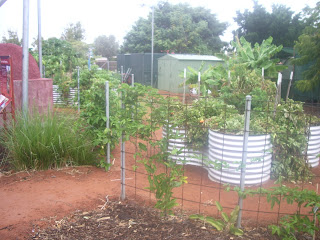Day 3 in Karratha and we are off to visit two schools in the Port Hedland area. Not such a long journey today…. a mere 2 ½ hours each way and no dirt tracks. Very civilised! Not such an arduous trip today, but an early start. Our guide, Bruce, is attending meetings in Hedland (that’s local talk for Port Hedland!) while we are at our first school. So, after a 6.30am pick up we are on our way to Port Hedland Primary and South Hedland Senior Secondary School. Port Hedland and South Hedland are two distinct areas around 10 kilometres apart.

Our first stop today is at Port Hedland Primary School where Kane Benson is the Principal. Port Hedland is a school of 406 students of which about 20% are of indigenous background. A further 25% of the student population move into and out of the school each year. The transience of the community is due to movement in the aboriginal community and the high turnover of families working with BHP – the major employer in the town. More than half the aboriginal children live in two communities in the town – the “three mile camp” and the “one mile” camp referring to the distance from the port. Other indigenous families, employed by BHP live in company housing.

Principal, Kane Benson, has been at Port Hedland for about two years. He is a Pilbara boy born and bred and is a committed professional with a strong empathy for his students. Kane holds a clear vision for his school and fully expects his staff to hold high expectations for the learning outcomes of their students. Like other schools we have visited, Kane was focussed on the recent NAPLAN results and planning to continually improve the achievement levels of the students. He believes the children at Port Hedland should achieve at the same level as other children in Western Australia.
There were many highlights of our visit to Port Hedland Primary School. Firstly, the previous Friday, the school had received an award in the local, prestigious BHP Schools Awards for Community Partnerships. This award related to the school’s development of “Operation Barn”. This monthly program sees members of the school staff, local police and DCP visit the local aboriginal community – Three Mile. The group offer a BBQ, activities and community support, such as cleaning up around the camp. This allows members of the community an informal opportunity to mix and talk with school staff, building trust and mutual respect. Within the first year, the school has seen an increase in communication with members of this important element of the school community. Congratulations, Port Hedland
Port Hedland Primary has implemented the Better Buddies Program in the school. Whilst the program is still in its infancy and results are yet to be determined, the school has introduced a Buddy Program between the Year 1 and Year 6 students. Kane visited schools in Melbourne in 2009 to investigate the Better Buddies Program.
Important indigenous occasions, such as NAIDOC Week, are celebrated across the school. AEIO, Hilary Saunders organises a schedule of activities that highlight the achievements of members of the indigenous community and encourage the children to celebrate their aboriginality. Hilary also plays a major role in the “Operation Barn” program and is a key conduit between the school and aboriginal families. Since, the programs have commenced, Hilary has noticed aboriginal families contacting her to notify the school if the children would be absent to attend important family occasions like funerals. This level of communication is a vast improvement. Another of Hilary’s roles is arranging the Breakfast Club. On the day of our visit, 82 children attended Breakfast Club. This was a record for the school.
An impressive secondary school transition program operates between Port Hedland Primary School and Hedland Senior High School. Supported by BHP funding, the Year 7 students are transported to the High School one day per week throughout second semester. This ensures the children are well prepared to commence secondary school.
Port Hedland Primary operates a School Council of elected parents and staff. The Principal, staff and parents enjoy positive and productive relationships. The Parents’ Association are a highly successful fundraising group that raising significant funds to support learning in the school.
The teaching staff at Port Hedland work together as a cooperative professional team. Regular staff meetings include all teaching staff from Kindy – Year 7. The staff supervise all areas of the playgrounds so they get to know all children rather than the Kindy and Pre-Primary teachers remaining with just their own groups in a separate play space. Kindy children attend 3 days per week. On the days when there is no Kindy program operating, the staff teach other classes in the school.
Our visit to Port Hedland Primary was a glimpse of a school more closely related to our own in Melbourne. It was powerful to see how a school in a community with high parental expectations, still manages to address the diverse and high-level needs of the aboriginal children in the school community.






























